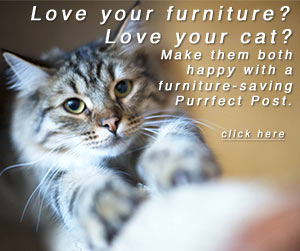STOMP out Problem Cat Scratching

- Does your sofa look like a bear attacked it?
- Are your door frames splintered like a cougar has climbed them?
- Does problem cat scratching have you down?
If you live with cats, you live with scratching. It's a fact of feline life. Indeed, cats need to scratch to stay physically and mentally healthy. Cats don't scratch your belongings because they're mad at you, they scratch for these reasons:
- They need to mark their territory. Even if you don't have other cats in your home, marking territory by leaving scratch marks and odors from scent glands in their paws is an inborn feline behavior.
- They are keeping their muscles, ligaments, and tendons healthy. Scratching provides a great full-body workout and stretch for cats.
- They are keeping their claws healthy. Cats' claws grow out in layers, like an onion. Scratching at things removes the outer, dry layers of the claws for cats so the inner, healthy layers can be revealed. It's a common misconception that cats scratch to sharpen their claws, but that isn't the case.
- They are letting off steam. Cats use scratching as stress relief. If they aren't able to scratch to let off steam, they may develop unwanted behaviors like urinating outside the litter box.
Now that you know why scratching is necessary to keep your cat healthy, you're ready to learn how to STOMP out problem cat scratching.
S: Suppress Stress
Cats may scratch items in a home if they're feeling stress, and they can feel stress for a variety of reasons. Some of these include new people or pets in the home, people or pets leaving the home, new schedules, noise, or an outside cat hanging around.
One of the best ways to combat stress in cats is through interactive play. Schedule at least 10 minutes a day of time to play with your cat. The type of play that relieves the most stress for cats is that which lets them exercise their predator instincts. Use toys that mimic prey behavior such as wand toys that act like birds or small toys that can be made to move like rodents.
Providing your cat with a cat tree that can be placed near a window can also be stress-relieving. Cats love to watch things that go on outside, so a tree such as the Purrfect View, placed near a window, can be nice and relaxing.
T: Trim Claws Regularly
Cats' claws curve as they grow out. This helps a cat hold on to prey. Keeping the claws trimmed back by snipping off the curved part can help decrease any damage that is done to items if your cat does scratch at them. These clippers work great for trimming cats' claws.
You can learn more about how to trim your cat's claws here: "Cat Nails: Trimming Cats' Claws."
O: Outsmart Your Feline Friend
This part of STOMPing out problem cat scratching takes some strategy on your part. You need to make the inappropriate spots that your cat is scratching (like the sofa) unappealing to him. Make it seem like they are the worst places in the world to scratch.
You can do this by covering furniture tightly with a heavy blanket, spraying cat-safe citrus sprays on surfaces because cats dislike citrus, or using aluminum foil or double-sided tape to cover carpet or furniture (some surfaces and materials may be damaged by tape: use at your own discretion).
If there's a particular thing that you know your cat doesn't like, use it to your advantage to deter him from scratching inappropriate items. You will be able to remove or stop using the deterrents once your cat is reliably using an alternative (see next section).
Never use punishment or hitting to keep a cat from scratching something inappropriate. These methods are not only inhumane, but they may also create more unwanted behavior by causing your cat stress.
M: Maintain Proper Alternatives
Cats need to scratch, so if you are going to require that yours not scratch your belongings, you absolutely must supply him with an acceptable alternative. That means acceptable to your cat as well as to you.
In the wild, the perfect cat scratching post is a tree, and that's the type of object that a cat wants to scratch:
- Something extremely stable that won't wobble and topple over when a cat leans into it.
- Something tall enough for a full-grown cat to stretch out against completely, to exercise the muscles and tendons from his neck to his toes.
- Something with a rough, shreddable surface so cats can leave territorial messages for other cats.
Luckily, you don't need to drag a dirty tree trunk into your home. You can get a Purrfect Post. They are built to mimic the tree trunks that wild cats love to scratch. They're solid and won't topple over when cats lean on them, they're tall (The Mondo measures 39 inches), and they're covered in sisal fabric, which is rough but provides an excellent, satisfying scratching motion for cats.
Getting Purrfect Posts and placing them in the right spots in your home can help ensure that your cat will leave your furniture alone. Here are some things to remember when determining where to place your posts:
- Cats want posts in high-traffic, high-visibility areas of the home. This is because of the "marking territory" reason that cats scratch. Even if you don't have other cats in your home, your cat is innately driven to leave visible marks and odors from scent glands in his paws to show where his territory lies.
- Cats like to scratch when they first wake up. Placing posts near favorite sleeping spots is a good idea.
- Cats don't want to travel too far to find a post. If you have multiple levels in your home, you'll want posts on each one. This can help eliminate problems with a cat that scratches a post in one area of your home but furniture in another. If you have multiple cats, you'll need multiple posts to discourage rivalry.
P: Place Soft Paws® on Claws
For extra insurance against cat scratching damage, use Soft Paws®. These are vinyl caps that slide right over your cat's claws. They're held on by non-toxic adhesive, and they stay on for several weeks (after the initial period of your cat getting used to them).
Soft Paws® do not interfere with your cat's claw retraction or extension, and there's no risk of infection because they are applied to the claws, not the skin.
Your cat will still be able to and want to use his scratching post with Soft Paws® applied, but if he does happen to scratch at something else, damage will be much less likely to occur.
There you have it: if you are dealing with inappropriate cat scratching, don't stomp around in anger, STOMP it out with knowledge and appropriate tools instead.
You May Also Like These Articles/Recipes:
Soft Paws Can Help with Life Transitions
The Ragdoll Cat and Cat Scratching Posts
Benefits of a Good Cat Scratching Post
Training A Cat or Kitten to Use a Scratching Post
Choosing the Best Cat Scratching Post
Sisal Fabric: The Best Material for Cat Scratching Posts
Cat Scratching Posts and Maine Coon Cats
The Benefits of Having Multiple Cat Scratching Surfaces




